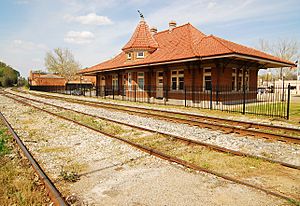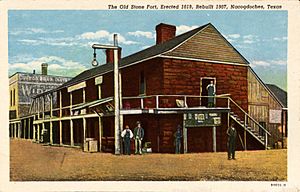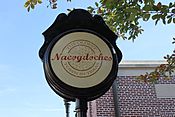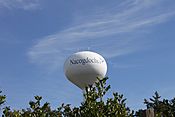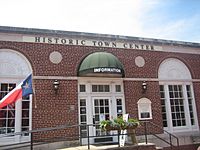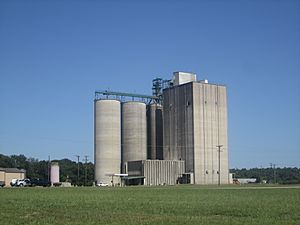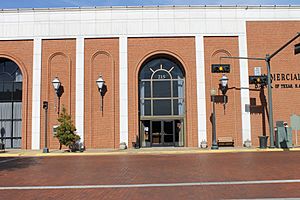Nacogdoches, Texas facts for kids
Quick facts for kids
Nacogdoches, Texas
|
|
|---|---|
| City of Nacogdoches | |
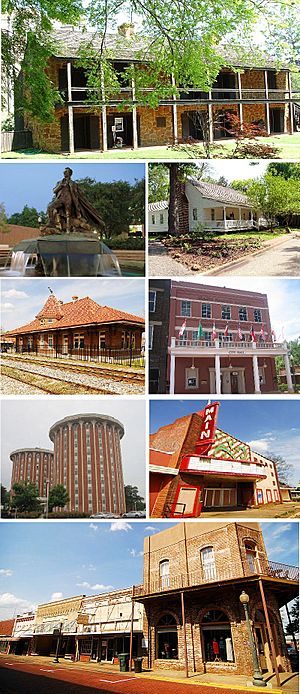
Clockwise from top: Old Stone Fort, Adolph Stern House, Nacogdoches City Hall, Nacogdoches downtown, Gladys E. Steen Dorms, Depot, Stephen F. Austin statue
|
|
| Nickname(s):
"The Oldest Town in Texas"
|
|
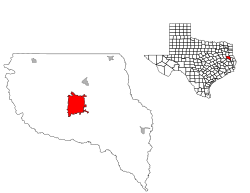
Location of Nacogdoches, Texas within Nacogdoches County
|
|
| Country | |
| State | |
| County | Nacogdoches |
| Incorporated (as a town) | 1837 |
| Incorporated (as a city) | 1929 |
| Government | |
| • Type | Council-Manager |
| Area | |
| • Total | 27.66 sq mi (71.64 km2) |
| • Land | 27.61 sq mi (71.51 km2) |
| • Water | 0.05 sq mi (0.13 km2) |
| Elevation | 302 ft (92 m) |
| Population
(2010)
|
|
| • Total | 32,996 |
| • Estimate
(2019)
|
32,877 |
| • Density | 1,190.81/sq mi (459.78/km2) |
| Demonym(s) | Nacogdochian |
| Time zone | UTC-6 (Central (CST)) |
| • Summer (DST) | UTC-5 (CDT) |
| ZIP codes |
75961-75965
|
| Area code(s) | 936 |
| FIPS code | 48-50256 |
| GNIS feature ID | 1363573 |
Nacogdoches ( NAK-ə-DOH-chis) is a small city in East Texas and the county seat of Nacogdoches County, Texas, United States. The 2020 U.S. census recorded the city's population at 32,147. Nacogdoches is a sister city of the smaller, similarly named Natchitoches, Louisiana, the third-largest city in the southern Ark-La-Tex. Stephen F. Austin State University is located in Nacogdoches.
Contents
History
Early years
Local promotional literature from the Nacogdoches Convention & Visitors Bureau describes Nacogdoches as “the oldest town in Texas.” Evidence of settlement at the same site dates back to 10,000 years ago. It is near or on the site of Nevantin, the primary village of the Nacogdoche tribe of Caddo Indians.
Nacogdoches remained a Caddo Indian settlement until the early 19th century. In 1716 when Spain established a mission there, Nuestra Señora de Guadalupe de los Nacogdoches. That was the first European construction in the area. The “town” of Nacogdoches got started after the French had vacated the region (1760s, following the French and Indian War), and Spanish officials decided that maintaining the mission was too costly. In 1772 they ordered all settlers in the area to move to San Antonio. Some were eager to escape the wilderness, but others had to be forced from their homes by soldiers. It was one of the original European settlements in the region, populated by Adaeseños from Fort Los Adaes.
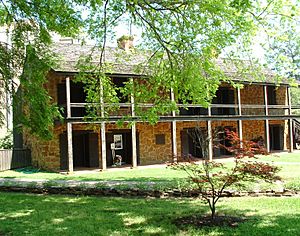
Colonel Antonio Gil Y'Barbo, a prominent Spanish trader, emerged as the leader of the settlers, and in the spring of 1779, he led a group back to Nacogdoches. Later that summer, Nacogdoches received designation from Spain as a pueblo, or town, thereby making it the first “town” in Texas. Y'Barbo, as lieutenant governor of the new town, established the rules and laws for local government. He laid out streets with the intersecting El Camino Real (now State Highway 21) and La Calle del Norte/North Street (now Business U.S. Highway 59-F) as the central point. On the main thoroughfare, he built a stone house for use in his trading business. The house, or Old Stone Fort as it is known today, became a gateway from the United States to the Texas frontier.

1800s
The city has been under more flags than the state of Texas, claiming nine flags. In addition to the Six Flags of Texas, it also flew under the flags of the Magee-Gutierrez Republic, the Long Republic, and the Fredonian Rebellion. People from the United States began moving to settle in Nacogdoches in 1820 and Texas' first English-language newspaper was published there. However, the first newspaper published (in the 1700s) was in Spanish. An edition of the newspaper (in Spanish) is preserved and shown at the local Museum.
In 1832, the battle of Nacogdoches brought many local settlers together, as they united in their stand to support a federalist form of government. Their successful venture drove the Mexican military from east Texas.
Thomas Jefferson Rusk was one of the most prominent early Nacogdoches Anglo settlers. A veteran of the Texas Revolution, hero of San Jacinto, he signed the Texas Declaration of Independence and was secretary of war during the Republic of Texas. He was president of the Texas Statehood Commission and served as one of the first two Texas U.S. Senators along with Sam Houston. He worked to establish Nacogdoches University, which operated from 1845 to 1895. The Old Nacogdoches University Building was added to the National Register of Historic Places in 1971. Rusk died on July 29, 1857.
Sam Houston lived in Nacogdoches for four years prior to the Texas Revolution (1836) and opened a law office downtown. He courted Anna Raguet, daughter of one of the leading citizens, but Anna rejected him after finding that he was not divorced from his first wife Eliza Allen of Tennessee.
William Goins (Goyens, Goings, Going), the son of a white mother and black father, operated a local inn, trucking service, blacksmith works and maintained a plantation outside Nacogdoches on Goins Hill. He was married to a white woman and owned slaves. He was appointed as an agent to treat with the Cherokees and was prominent in providing assistance to the Texas Army during the Revolution.
Adolphus Sterne was a merchant of German Jewish extraction who maintained the finest home in town. Frequently visited by famous luminaries such as Sam Houston, Thomas Rusk, Chief Bowles, David Crockett and many others, his diary is one of the best sources for early Nacogdoches history.
Nacogdoches also contains one of the last surviving family owned homestead plantations in east Texas, August Tubbe Plantation, owned and operated by the same family that established it in 1859. August Tubbe was a German-born immigrant who, with his elderly mother, left Germany in 1858 and arrived in Nacogdoches Texas by 1859. Their lives are recounted in several books, including a historical fiction novel by Gisela Laudi entitled “This is what I want to give ye report on; I am Justina Tubbe”. Tubbe plantation is historically significant in the formation of early life in east Texas, not only in its cotton and sugarcane, but because it later played an important part in milled-lumber production. Tubbe Sawmill was actually the first water, and then steam, powered sawmill in Nacogdoches. During renovations of the Cason-Monk buildings in the early 21st century, boards stamped with Tubbe mill logos made it possible to date the building. The estate contains one of the largest privately owned genealogical archives pertaining to the Tubbe family in existence; providing important insight into early settlers life during the 19th century. The family has been featured in a number of German museums including the Expo2000 in Bremerhaven Germany. The estate and archives are privately owned and maintained by a descendant of its original founder, and are currently available for study through private appointment only. The Tubbe family is considered to be one of the "founding families" of Nacogdoches, making their mark in many ways spanning over 150 years. August Tubbe was responsible for not only his large 2,000 acre plantation, sawmill, and participation in Milam Masonic Lodge, but also is credited with bringing the now defunct Texas and New Orleans Railroad spur into town. Tubbe estate as a whole is now owned and managed by Thomas VonAugust Tubbe-Brown, the fifth generation grandson of August Tubbe.
In 1859, the first oil well in Texas began operation here, but it was never so well known as Spindletop, drilled in 1901 near Beaumont. Lyne Taliaferro Barret began this operation, which was interrupted by the American Civil War. However, after the war Barret returned to Oil Springs, an area about 13 miles east of Nacogdoches, to resume his project by acquiring another drilling contract in 1865. Barret struck oil on September 12, 1866, at a depth of 106 feet. The well produced around 10 barrels of oil per day, but was recorded to produce anywhere from 8 to 40 barrels. In 1868, the price of oil dropped so low that Barret lost his financial backing, and was forced to resign the project. The fields then laid dormant for another 20 years, until 1889 when various drilling companies had 40 wells on the site. The site was never very productive, only yielding 54 barrels in 1890. However, it remains the first and oldest Oil well in Texas, with production being recorded into the 1950s.
1900s–present
In 1912, the Marx Brothers came to town to perform their singing act at the old Opera House (now the SFA Cole Art Center). A historic plaque commemorating the event is posted in downtown Nacogdoches.
John Wayne mentioned the town in some of his movies e.g. Big Jake.
In 1997, singer Willie Nelson came to Nacogdoches to perform with his friend, Paul Buskirk, a renowned mandolin player. During his stay, Nelson recorded a number of jazz songs at Encore Studios. In 2004, he released those recordings on an album called Nacogdoches.
On February 1, 2003, the Space Shuttle Columbia broke up during re-entry, depositing debris across Texas. Much of the debris landed in the Nacogdoches area, and much of the media coverage of the recovery efforts focused on Nacogdoches.
On September 24, 2005, Hurricane Rita struck Nacogdoches as a Category 1 hurricane. Nacogdoches experienced the same problems Houston was having because of the unprecedented number of people evacuating the Houston-Galveston area. The city's local shelters were already overwhelmed with evacuees that had come from New Orleans because of Hurricane Katrina. Long lines at gas stations, shortages of supplies, food and fuel were widespread. Many Houstonians took the Eastex Freeway (U.S. Highway 59) (Future Interstate 69) out of Houston to evacuate through East Texas. Travel times between Nacogdoches and Houston were reported taking about 24–36 hours, when normal travel time is about two hours. As a result of Hurricane Rita, U.S. Highway 59 (Future Interstate 69) has been designated as an evacuation route by TXDOT, with all of it lanes to be used for contraflow traffic. Nacogdoches was designated as the north end terminus of the contraflow/evacuation route.
On September 13, 2008, Hurricane Ike struck Nacogdoches as a Category 1 hurricane.
Nacogdoches hosts the Texas Blueberry Festival on the second Saturday in June. The county is the top blueberry producer in Texas. The city recently tagged itself as the “Capital of the Texas Forest Country.” The community is one of the first Texas Certified Retirement Communities. The community celebrates a host of other events year round visitnacogdoches.com
Once a Democratic stronghold, Nacogdoches has in recent years moved steadily toward the Republican Party, being represented in the United States Congress and the Texas State Legislature by Republicans. The city in general is very moderate with the co-existence of students of Stephen F. Austin with a left-of-center persuasion and conservative right-of-center city residents.
Nacogdoches has been in the Texas Main Street Program since 1998. It is preserve America Community and a Texas Treasures Award winner. Nacogdoches Downtown was named the “Best Historic Venue” by Texas Meetings and Events magazine. Nacogdoches was nominated as one of the “Friendliest Towns in America” by Rand McNally and USA Today.
Nacogdoches is the headquarters of the Texas Wing of the Civil Air Patrol, the Air Force Auxiliary. CAP provides emergency services, such as search and rescue for airplane crashes; aerospace education; and cadet programs throughout the United States. Texas Wing has 1516 Senior (adult) Members and 1636 Cadet (teenage) Members.
Geography
Nacogdoches is located at 31°36′32″N 94°39′3″W / 31.60889°N 94.65083°W (31.608855, -94.650862). Its location is approximately 140 miles (225 km) NNE of Houston, 180 miles (290 km) SE of Dallas and 90 miles (145 km) SW of Shreveport.
According to the United States Census Bureau, the city has a total area of 25.3 square miles (66 km2), of which 25.2 square miles (65 km2) is land and 0.1 square miles (0.26 km2) (0.24%) is water. The city center is located just to the north of the fork of two creeks, the LaNana and Banita.
Lake Nacogdoches is located 10 miles (16 km) west of the city.
Climate
| Weather chart for Nacogdoches, Texas | |||||||||||||||||||||||||||||||||||||||||||||||
|---|---|---|---|---|---|---|---|---|---|---|---|---|---|---|---|---|---|---|---|---|---|---|---|---|---|---|---|---|---|---|---|---|---|---|---|---|---|---|---|---|---|---|---|---|---|---|---|
| J | F | M | A | M | J | J | A | S | O | N | D | ||||||||||||||||||||||||||||||||||||
|
4.4
57
36
|
3.9
62
40
|
4.2
69
47
|
4.1
76
55
|
4.8
83
64
|
4.1
90
71
|
2.9
93
74
|
3.1
94
73
|
3.7
88
67
|
4
79
56
|
4.6
68
45
|
4.6
59
38
|
||||||||||||||||||||||||||||||||||||
| temperatures in °F precipitation totals in inches source: Weather.com / NWS |
|||||||||||||||||||||||||||||||||||||||||||||||
|
Metric conversion
|
|||||||||||||||||||||||||||||||||||||||||||||||
- On average, the warmest month is August.
- The highest recorded temperature was 112 °F or 44.4 °C in 2000.
- The average coolest month is January.
- The lowest recorded temperature was 3 °F or −16.1 °C in 1989.
- The most precipitation on average occurs in May.
Demographics
| Historical population | |||
|---|---|---|---|
| Census | Pop. | %± | |
| 1850 | 468 | — | |
| 1860 | 485 | 3.6% | |
| 1870 | 500 | 3.1% | |
| 1880 | 333 | −33.4% | |
| 1890 | 1,138 | 241.7% | |
| 1900 | 1,827 | 60.5% | |
| 1910 | 3,369 | 84.4% | |
| 1920 | 3,546 | 5.3% | |
| 1930 | 5,687 | 60.4% | |
| 1940 | 7,538 | 32.5% | |
| 1950 | 12,327 | 63.5% | |
| 1960 | 12,674 | 2.8% | |
| 1970 | 22,544 | 77.9% | |
| 1980 | 27,149 | 20.4% | |
| 1990 | 30,872 | 13.7% | |
| 2000 | 29,914 | −3.1% | |
| 2010 | 32,996 | 10.3% | |
| 2019 (est.) | 32,877 | −0.4% | |
| U.S. Decennial Census | |||
According to the 2010 census, Nacogdoches had a population of 32,996. The racial and ethnic composition of the population was 51.2% White, 28.4% Black, 0.5% Native American, 1.8% Asian, 0.1% Pacific Islander, 0.1% reporting some other race, 2.3% reporting two or more races, and 16.8% Hispanic or Latino American.
At the census of 2000, 29,914 people, 11,220 households, and 5,935 families resided in the city. The population density was 1,185.9 people per square mile (457.8/km2). The 12,329 housing units averaged 488.7 per square mile (188.7/km2). The racial makeup of the city was 65.98% White, 25.06% African American, 1.13% Asian, 0.34% Native American, 0.11% Pacific Islander, 5.84% from other races, and 1.55% from two or more races. Hispanics or Latinos of any race were 10.82% of the population.
In 2020, the U.S. Census Bureau reported the city's population was 32,147, a slight decline since 2010. At the 2019 American Community Survey's five year estimates program, the racial and ethnic makeup of the city was 51.0% non-Hispanic white, 26.1% Black or African American, 0.1% Native American, 2.3% Asian, 1.6% two or more races, and 18.8% Hispanic or Latino American of any race. A year later, the 2020 census tabulated a majority non-Hispanic white population.
Of the 11,963 households in 2019, the average family size was 3.06 and 53.2% of the total population were married. In contrast to several growing cities in Texas, the median age was 24.4 in 2019.
The median household income for the city was $54,444 from 2014 to 2019, against the statewide median household income of $64,034. Married-couple families had a median household income of $78,843 while non-family households had a median income of $22,076. Among the population, 31% of the city lived at or below the poverty line; 34% of the population aged 18 to 64 lived at or below the poverty line, and 33.9% of the population under age 18 lived at or below the poverty line.
There was a median gross rent of $771 in contrast with the statewide median gross rent of $1,091 at the 2019 American Community Survey. Among the population, there was a 37.5% homeownership rate and 2,068 vacant housing units in the city limits as of the 2020 census.
Points of interest

- Mast Arboretum
- Millard's Crossing Historic Village
- Old Stone Fort Museum
- Historic Downtown
- Sterne-Hoya house
- Oak Grove Cemetery
- Zion Hill First Baptist Church
- Ruby Mize Azeala Garden
- Durst Taylor House
- Camp Tonkawa
- Stone Fort
- Old University building
Economy
The economy of Nacogdoches is heavily dependent on Stephen F. Austin State University. Like many college towns in the United States, Nacogdoches businesses heavily depend on university students as customers and regularly employ them. Other large sectors of the local economy are healthcare, manufacturing, agriculture, and lumber.
According to the city's 2017 Comprehensive Annual Financial Report, the top employers in the city were:
| # | Employer | Employees 2017 | Employees 2008 | Rank 2008 |
|---|---|---|---|---|
| 1 | Stephen F. Austin State University | 1,659 | 1,500 | 1 |
| 2 | Pilgrim's Pride | 1,657 | 1,200 | 2 |
| 3 | Nacogdoches Independent School District | 972 | 880 | 4 |
| 4 | Nacogdoches County Hospital District | 874 | 650 | 5 |
| 5 | Etech, Inc. | 565 | 900 | 3 |
| 6 | Nacogdoches Medical Center | 545 | 575 | 6 |
| 7 | Walmart | 473 | 460 | 7 |
| 8 | City of Nacogdoches | 323 | 350 | 10 |
| 9 | Nacogdoches County | 275 | (not specified) | |
| 10 | Eaton (Cooper Power Systems) | 257 | (not specified) | |
| NIBCO | (not specified) | 400 | 8 | |
| Foretravel Motorcoach | (not specified) | 350 | 9 |
Education
The city of Nacogdoches is primarily served by the Nacogdoches Independent School District. Small portions of the city are also zoned into the Woden ISD. School districts serving surrounding areas include Central Heights, Douglass, Garrison, Martinsville, Chireno and Cushing districts.
Nacogdoches is home to Stephen F. Austin State University, which is a state institution of about 13,000 students. Stephen F. Austin is also home to the East Texas Historical Association. Angelina College operates a branch campus in Nacogdoches.
The Texas Legislature designated Nacogdoches County as being in the boundary of Angelina College's district.
Notable people
- Oscar P. Austin, Medal of Honor recipient
- Roy Blake, Sr., Texas legislator and businessman, and former Nacogdoches City Councillor
- Antonio Gil Y'Barbo, frontier trader
- Sam Houston, president of the Republic of Texas
- Kay Bailey Hutchison, U.S. Senator
- Joseph W. Kennedy, co-discoverer of plutonium
- Joe R. Lansdale, award-winning author and martial-arts expert
- Leslie Ludy, author and public speaker
- Thomas Jefferson Rusk, military leader and U.S. Senator
Athletes
- Grady Allen, former football player for the Atlanta Falcons
- Brandon Belt, baseball player
- Bucky Brandon, baseball player
- Domingo Bryant, football player
- Larry Centers, football player
- Clint Dempsey, former soccer player
- Philip Humber, baseball player
- Damion James, basketball player
- Mark Moseley, football player
- Bum Phillips, football coach
- Greg Roberts, former football player
- Jeremiah Trotter, football player
- Thomas Walkup, basketball player
Entertainers
- Tony Frank, actor
- Don Henley, musician
- Kasey Lansdale, actress and musician
- Bob Luman, musician
- Brad Maule, actor
- Ron Raines, actor
- Alana Stewart, actress, talk show host
Images for kids
-
Sterne–Hoya House of Adolphus Sterne, the first mayor of Nacogdoches, now a museum and library
See also
 In Spanish: Nacogdoches para niños
In Spanish: Nacogdoches para niños


